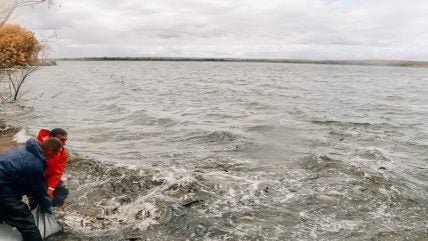
Employees of Russia’s Novovoronezh NPP have released six tonnes of juvenile silver carp into the cooling pond of unit 5 – a reservoir intended for cooling turbine condensers and heat exchange equipment. Stocking the pond with fish reduces the amount of phytoplankton and shellfish, and improves the quality of the water, which has a positive effect on the operation of the equipment. In addition, it helps maintain the ecological balance of the reservoir.
“More than 30 years ago, a problem arose – there were a lot of molluscs – river zebra mussels, and they began to clog the pump screens,” said Olga Romanova, public inspector of the Central Black Earth Interregional Department of Rosprirodnadzor and coordinator for sustainable development of the Novovoronezh NPP. Rosprirodnadzor is the Federal Service for Supervision of Natural Resources. “We had to clean them off with shovels and buckets, then a natural way was found, not chemical, purely ecological – with the help of fish. We decided to populate the reservoir with silver carp and grass carp, which showed the best results in the fight against mollusks, plankton, and bryozoans [aquatic invertebrates].”
Nuclear workers have been stocking the cooling pond with fish every year since 2012. Silver carp fry are released into the pond in autumn when they have grown to 150-300 grams and can adapt to the new reservoir most effectively. “In the spring, the eggs are just beginning to form, the fry are still too weak, and in the summer the water in the pond can warm up to more than 30 degrees, which adversely affects the survival of the fry,” said Igor Snegovskoy, leading specialist in the operation of hydraulic structures of the NPP supply systems workshop. “According to the recommendations of the Ministry of Fisheries, the water should be at a certain temperature, around 16-17 degrees, we achieve this temperature only in autumn.”
The fry are raised in a local fish hatchery located near the NPP. The fry are caught in batches of 300 kg, placed in containers and transported to the reservoir, where they are released through a special sleeve into the cooling pond. In addition to silver carp, the unit 5 reservoir is home to catfish, bream, grass carp, crucian carp, bleak, as well as tilapia, an exotic fish from Africa and South Asia that local fishermen love to catch. Since fish stocking began in 2012, the Novovoronezh NPP released more than 85 tonnes of fry of different fish species into the reservoir.
This is common practice at all Russian NPPs and other nuclear enterprises. Also in late October, Beloyarsk NPP released 120,000 black Amur carp into the Beloyarsk reservoir, the largest artificial reservoir in the Sverdlovsk Region. Black carp are listed in Russia’s Red Book of endangered species. The total weight of the fry was 3 tonnes, with each individual weighing at least 25 grams.
In one day, one four-year-old black carp can eat 1.4-1.8 kilograms of zebra mussel, a river mollusk widely distributed in freshwater bodies of Russia. It collects in cooling water pipelines, heat exchangers and fittings in turbine rooms of power plants that have external cooling ponds. “Fish stocking helps to improve the health and ecological condition of the reservoir, as well as reduce the overgrowth of the reservoir with higher aquatic vegetation,” said Nina Usatenko, head of the environmental protection department. “Black carp help to restore the ecological balance in the reservoir, disturbed by the rapid growth of the zebra mussel population in recent years.”
The Beloyarsk NPP populates fish in accordance with the calculations of the Ural branch of the State Fish Centre. For release into the reservoir, the fish is delivered by the contracting organisation in special containers on trucks from fish hatcheries in the Saratov region. Before releasing the fry, the water in the containers is gradually replaced with local water – the temperature of the water in the transport containers and in the reservoir is matched to make it easier for the fish to adapt to the new environment.
In total, in 2024, nuclear scientists released 388,000 fry of various fish species into the reservoir. In addition to black carp, 269,000 fry of bighead carp have made their home there, and by the end of this year it is planned to release another 90,000 fry of white carp. Over the entire stocking period from 2017 to 2024, the Beloyarsk Nuclear Power Plant released more than 2.7 million individuals into the reservoir, which are flourishing. Fishermen have already caught 20 kilograms of carp, and a silver carp can reach a weight of 50 kilograms.






